Buying Guides for Security Cameras
How to choose the right security camera for your needs.

SafeHome.org may receive compensation from some providers listed on this page. Learn More
We may receive compensation from some providers listed on this page. Learn More
How to choose the right security camera for your needs.


Ask any security professional what the most effective way to protect your home from burglars and trespassers is, and most will answer “security cameras and dogs” without hesitation.
That said, the category of “security cameras” covers a lot of ground. There are hundreds of manufacturers out there — thousands of camera models — and sifting through the bad to find the good can be daunting.
Not to worry. We’ve spent countless hours reviewing security cameras to give you the most detailed information available. We also keep an ear to the ground in this ever-evolving industry to provide you with the latest and greatest. For instance, did you know Ring recently released a dashboard cam? Or that SimpliSafe now offers camera monitoring through its Fast Protect program?
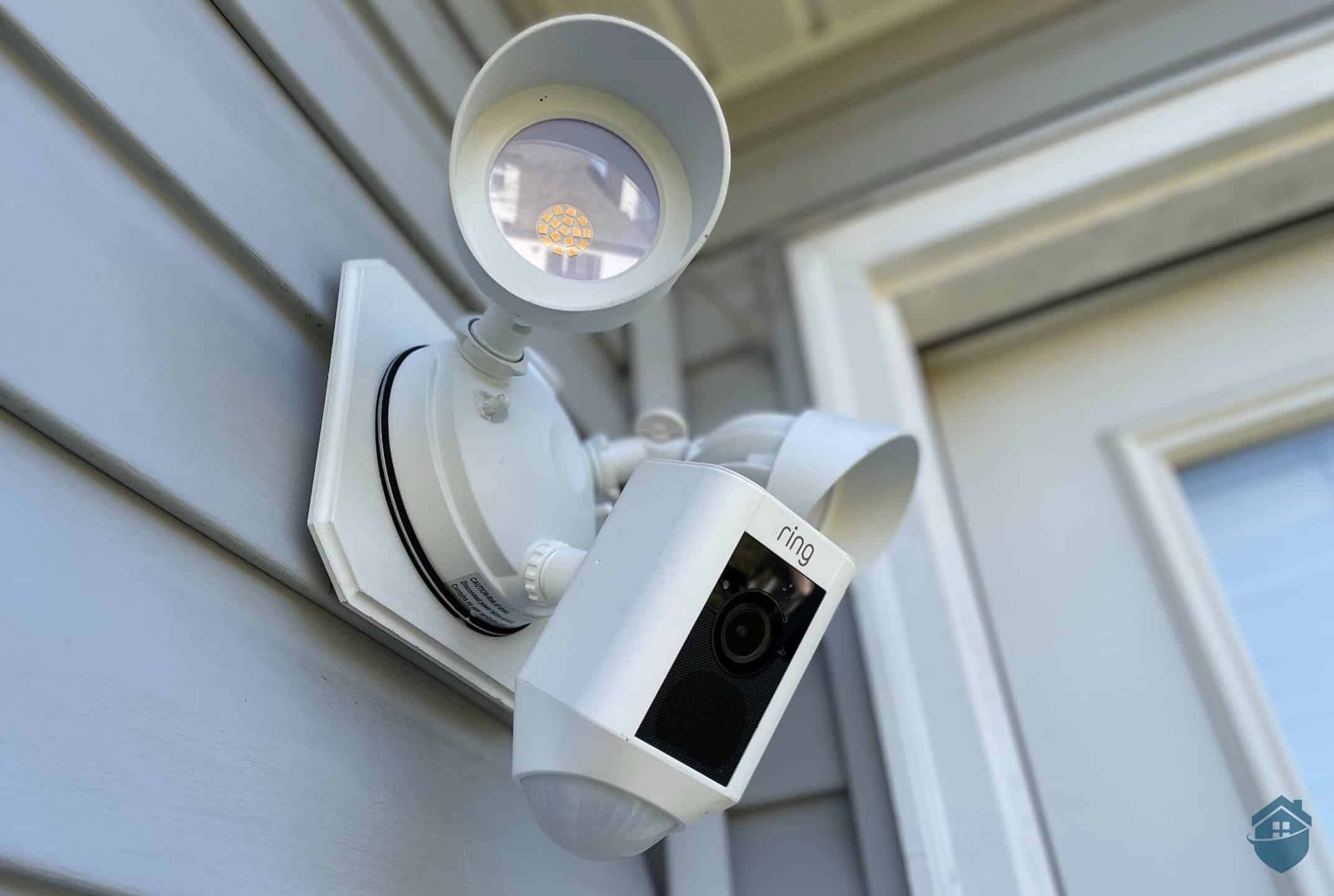
Ring Floodlight Cam
But with all this new technology flooding the market, it can make the buying process a little confusing. And while cameras themselves are getting easier to use, wading through the countless features, options, and pricing plans can be overwhelming when you try to make the right choice.
We will break down everything you need to know about security cameras here in this guide. We’ll talk about what you should be looking for, what some of the top models are, what features are important, and why you need cameras in the first place. We’ll cover everything there is to know about this ultra-competitive industry, and you’ll walk away with a much better understanding of how to protect your home and your family.


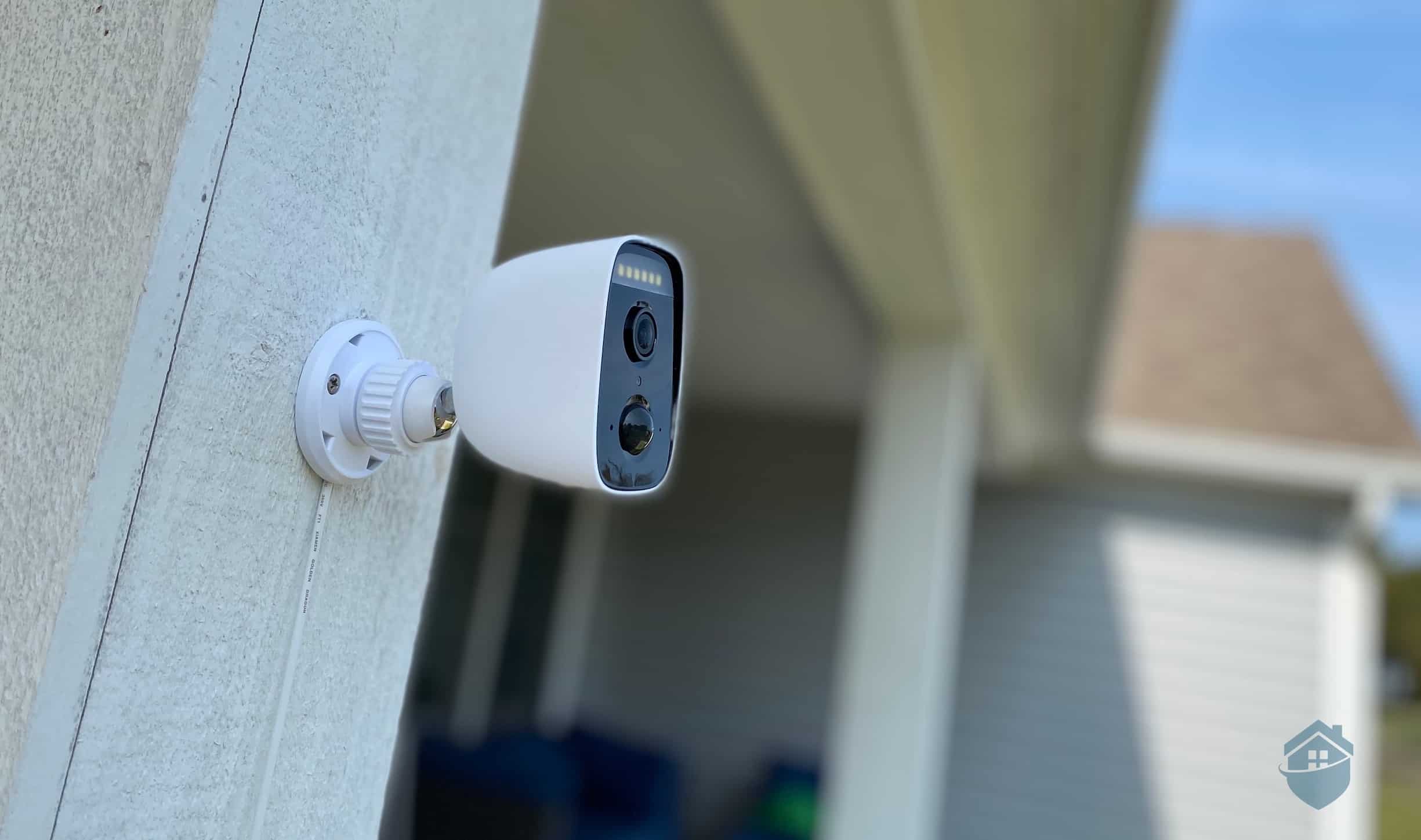
D-Link Camera Outside
So first things first. Why do you even need home security cameras? The simple answer is that they are one of the most effective crime deterrents out there. Burglars, vandals, and trespassers are all going to think twice when they see you’re keeping an eye on them.
We know some people who have purchased and installed a doorbell video simply as a deterrent. This is a great first step, but we always recommend targeting your camera purchase to specific threats or concerns.
After all, Nest’s battery-operated or wired doorbell camera won’t spot mischief-making teens cutting through our neighbor’s backyard at 4 a.m., so it might be smarter for us to go with a pair of solid 1080p Zmodo cameras and some extra lighting for our exterior instead.
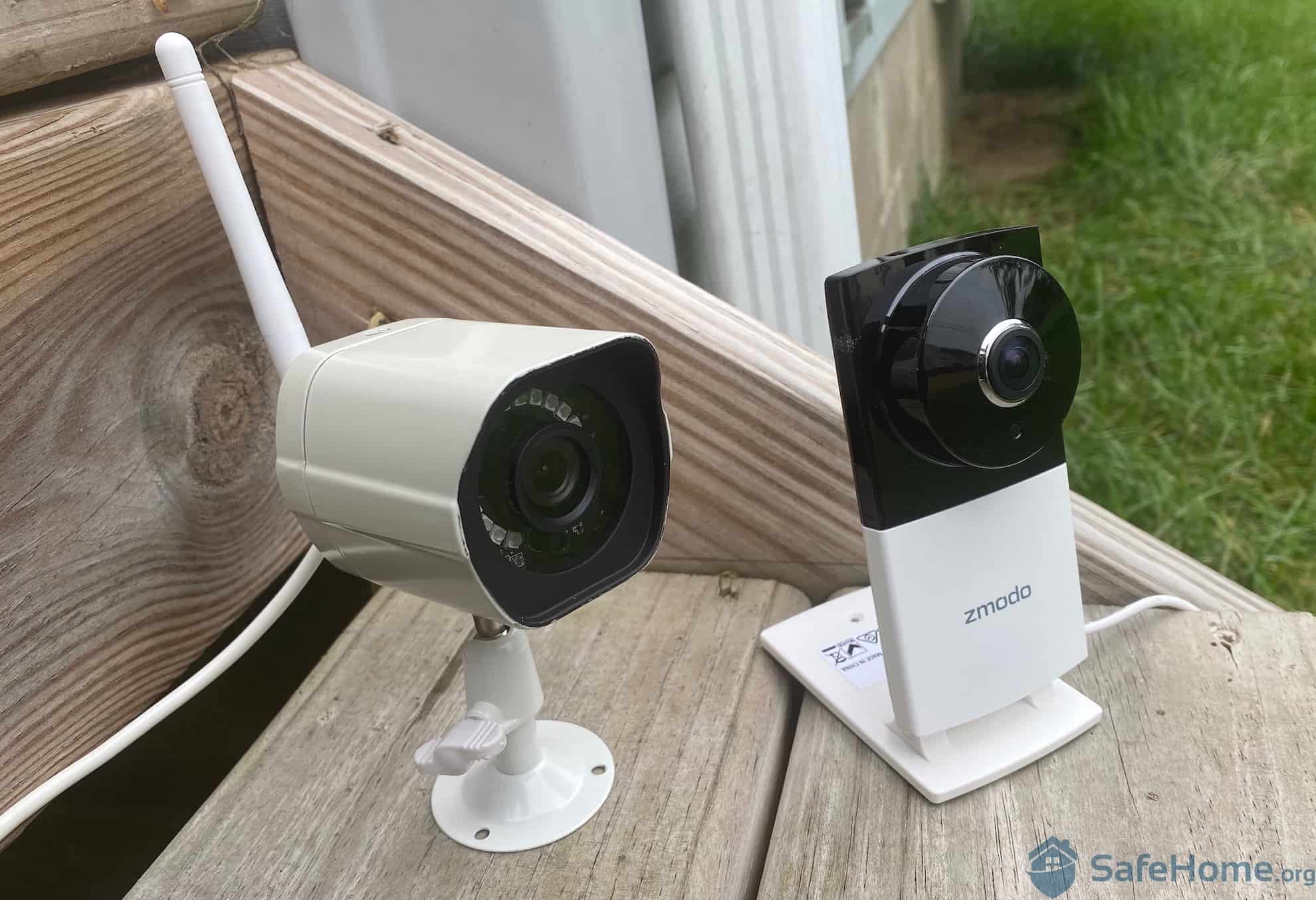
Zmodo Cameras
You may also be one of the many Americans who has turned to online shopping to save time and possibly money. However, packages sitting out on porches or stoops are ripe for theft. A good security camera can help you monitor your entryway and prevent this from occurring or even help you get your packages back if you do fall victim to porch pirates.
According to a recent crime study,1 36% of Americans have reported having a package stolen from their property at least once. Of those, 44% have had a package stolen at least twice. And very few (11%) said the porch pirate was caught and the package recovered.
With this in mind, you need to take inventory of your vulnerabilities and potential trouble spots around your property. Once you understand those, you’ll better understand what type of security camera you need to protect yourself. The good news is, whatever those needs are, you’re almost guaranteed to be able to find a camera tailor made to suit them. Now let’s get down to the nuts and bolts.
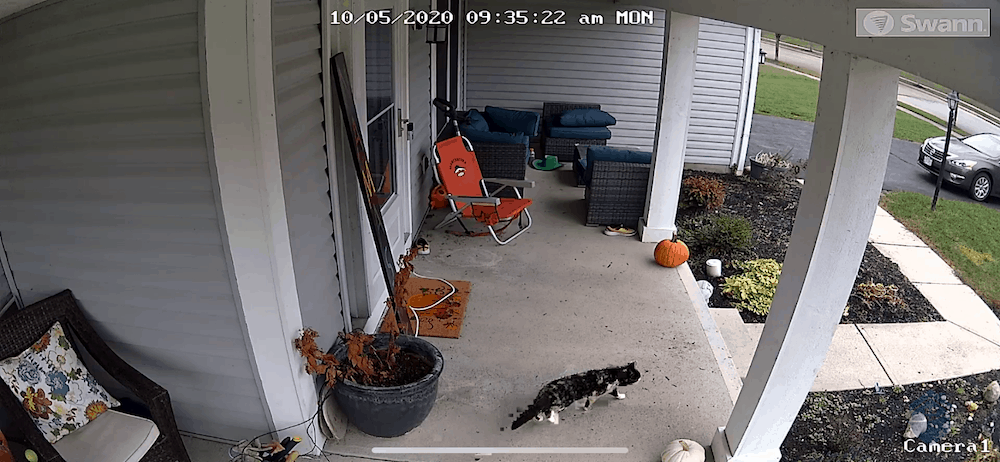
Swann Outdoor Video Quality
Identifying problem areas can be made much easier by viewing your home through the eyes of a burglar. Ask yourself, “If I were a burglar, how would I break into my home?” Think about what burglars look for and see if your home has those vulnerabilities. Check for areas with little to no lighting at night, places that would make good hiding spots for someone who’s sneaking in, and pathways where burglars can trudge through without raising suspicion.
Once you understand the trouble spots, you can decide on a security camera that will make them less problematic. Worried about a darkened corner of your backyard? Ring’s Spotlight Cam can take care of that potential hiding spot. Want to get really high tech? Invest in their Spotlight Cam Pro that can track someone’s movements through your property with 3D motion detection.
We’ve run into dozens of scenarios like these, and though we’ve (thankfully) never been burglarized ourselves, experts have warned2 for several years that it can be traumatic and devastating to find out that a stranger has been inside your home, rifling through your belongings. Security cameras can be an easy and inexpensive way to avoid this.
FYI: For more stats and insights on protecting your home from break-ins, check out our comprehensive Property Crime in America report.


These days, many different home security cameras are popping up in the market. But you can’t trust your home protection to just any fly-by-night brand. With this in mind, see below for a roundup of some great security camera options that we’ve personally tested and vetted. You’ll recognize many of the names, but there should be some new brands to explore as well.


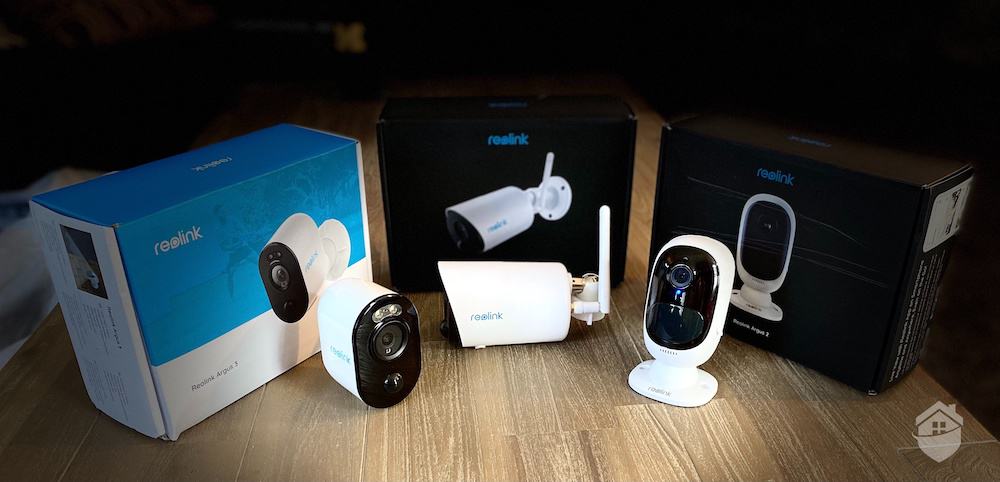
Reolink Argus 3, Argus Eco, and Argus 2
If you’re approaching the security camera industry for the first time, it’s easy to get overwhelmed. It’s not just that there are so many different brands and so many different models. Every camera out there comes with its own particular set of options, and it can certainly be challenging to sort all of them out, much less make a decision about which are the ones you need most.
Having lots of options is ultimately a good thing, though. It means whatever your particular security situation, you can find a device that’s going to work.
Just to give you an idea of what we mean, let’s talk about just a few of the more popular camera features you can get these days.
You want a camera that works fast and doesn’t hesitate. Part of this depends on the strength and speed of your Wi-Fi signal, but a good camera will always “wake up” the moment motion occurs to send you alerts on your phone. In our review of the SimpliCam, SimpliSafe’s dedicated indoor camera, we got lightning-fast performance, and as a result we recommend this camera as a solid pick for folks on a budget.
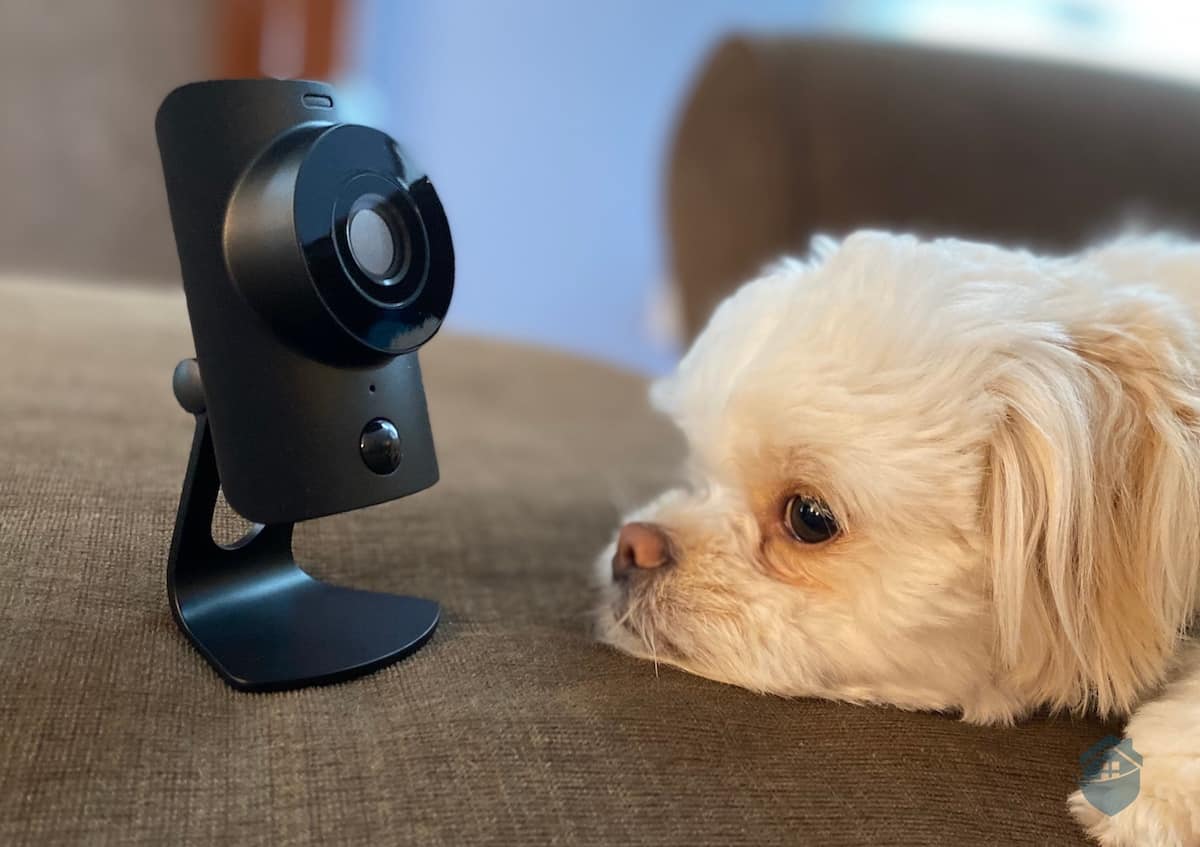
SimpliCam with Mookie
It’s worth pointing out that getting one great feature from a camera can cost you when it comes to other features. The SimpliCam offers a great example. The device features 1080p HD resolution. That’s not bad, but it pales in to comparison to some 2K and even 4K cameras on the market now.
Here’s the thing, though: lower-resolution video actually runs more smoothly over Wi-Fi than higher-resolution video from pricier competitors like Arlo and Google Nest3 because it requires less bandwidth. In other words, if you want great speeds, you sometimes have to sacrifice resolution.
By the way, if you’re curious, SimpliSafe frequently includes their SimpliCam (or its outdoor camera and video doorbell counterparts) free with their whole-home kits. Check out our full SimpliSafe system review for more.
Pretty much any security camera you buy today is going to come with an app. And, just like the cameras, each one has its own benefits and drawbacks. The best apps present the camera’s features and settings in intuitive, easy-to-use ways, while the more frustrating ones will have you digging through a clunky UI to find what you need.
FYI: In addition to helping with everyday tasks like monitoring the kids and pets, our camera’s mobile app is also a lifeline. If an intruder should show up on our property, we’ll be notified almost instantly, from anywhere.
The Blink app’s feed does a good job in this area, even automatically producing a highlight reel each day with short spurts of action that occurred in our home. We recommend Blink’s cameras and packages as a super-easy entry-level system. Entry-level sometimes has the connotation of lightweight, but Blink definitely impressed us in performance despite being pretty inexpensive. We paid just $100 for a battery-powered Blink Outdoor camera, which is an absolute steal.
Fancy Features: A few camera packages have started to appear with a thumbprint-activated safety feature built into the app. That way we can tap from anywhere, but no one else can get access.
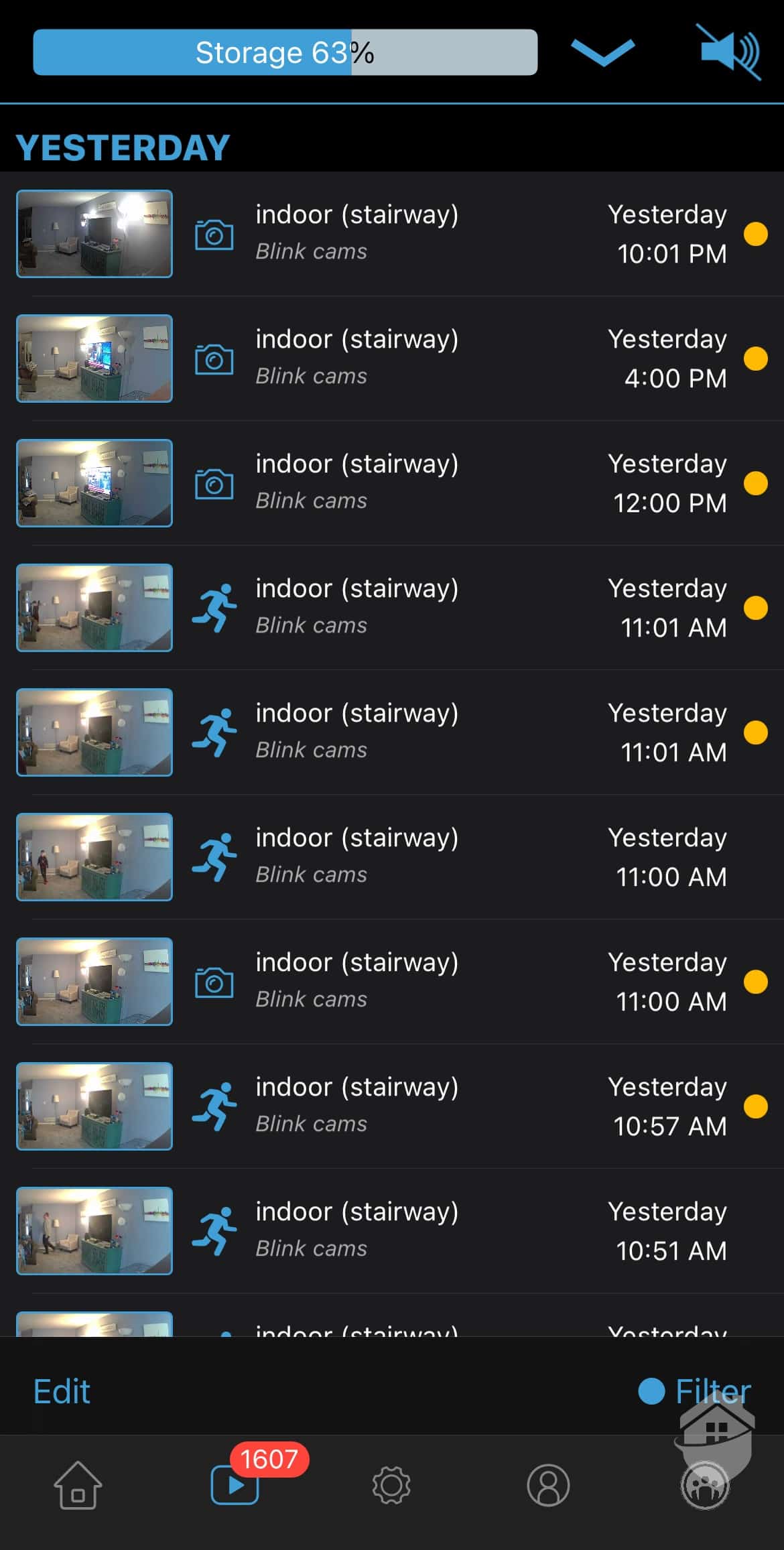
Blink App – Video History
You’ll find a lot of security cameras that claim 1080p video resolution. But this, too, can be a bit misleading. Many cameras will only reach that 1080p benchmark under the most ideal conditions, like when your Wi-Fi signal is running at full strength. With our sometimes-less-than-perfect Wi-Fi connection, we didn’t always get 1080p quality, even among the top-rated brands that are known for recording exceptional video. From time to time, our picture was pretty grainy.
But we might be a bit hyper-observant about this factor. As experts, we tend to pay extra attention to video quality in all of our reviews, as we know that resolution is one of the most important qualities people look for in a security camera. As an example, have a look at our view from the Blink Indoor Camera.
That is a 720p picture, which is still pretty clear!
In other words, as with speed, a video’s quality isn’t always about the resolution. There’s the framerate to consider, for example, and whether or not the camera uses High Dynamic Range (HDR).
That’s why it’s good to invest in a camera with flexible resolution settings. Google’s Nest cams do a great job of this. They have HDR, which maxes out at 1080p, but the camera can automatically adjust its resolution depending on the network speed. This means the camera is constantly going to be recording at the highest detail possible so you never miss anything.
We’ve seen some spectacular night vision images from our tests of security cameras. We’ve owned our home for a little over three years now, and we had no idea that so many deer showed up in our backyard on a nightly basis until we started checking out the nighttime view from our new Ring Floodlight Cam. Have a look below!
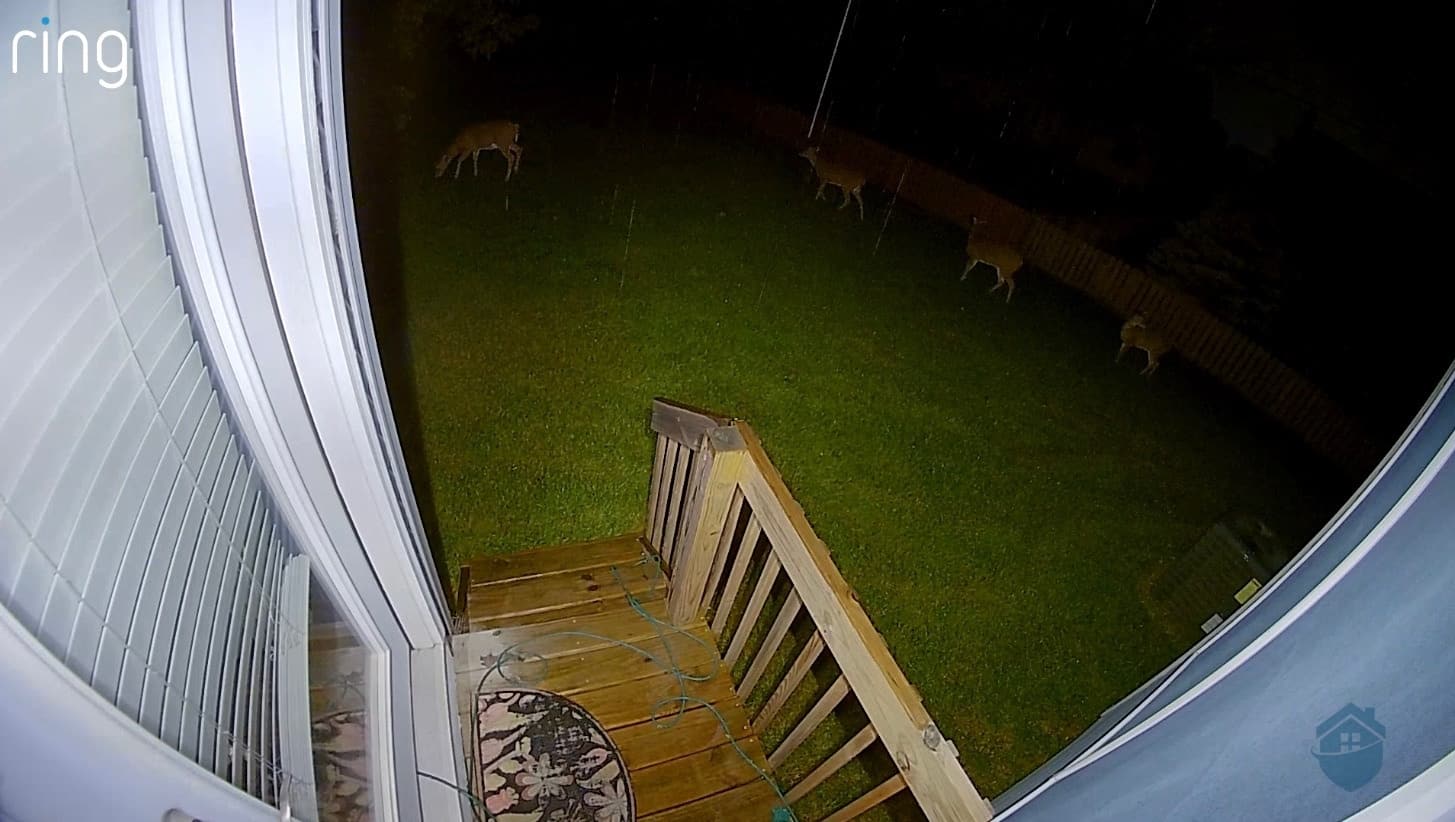
Ring Floodlight Cam Video Quality
We gave Arlo’s design-forward cams high marks in this category as well in our hands-on Arlo camera review. Do remember, though, that infrared night vision is pretty standard across cameras; you should be able to see your home at night no matter what. Of course, we always end up spending more money if we want full color night vision, so do keep that in mind.
Like 1080p and night vision, two-way audio has become a standard we expect in home security cameras. Even Wyze, one of the least expensive cameras on the market, has it. Now, we cannot tell a lie. If you take a look at our full Wyze Cam review, you’ll find we weren’t especially blown away with the quality of the audio in our tests. Still, it goes to show that even super-affordable cameras like the Wyze Cam offer two-way audio these days, if at sub-par quality. What we’re saying is that you probably want to steer away from cameras that don’t include it.
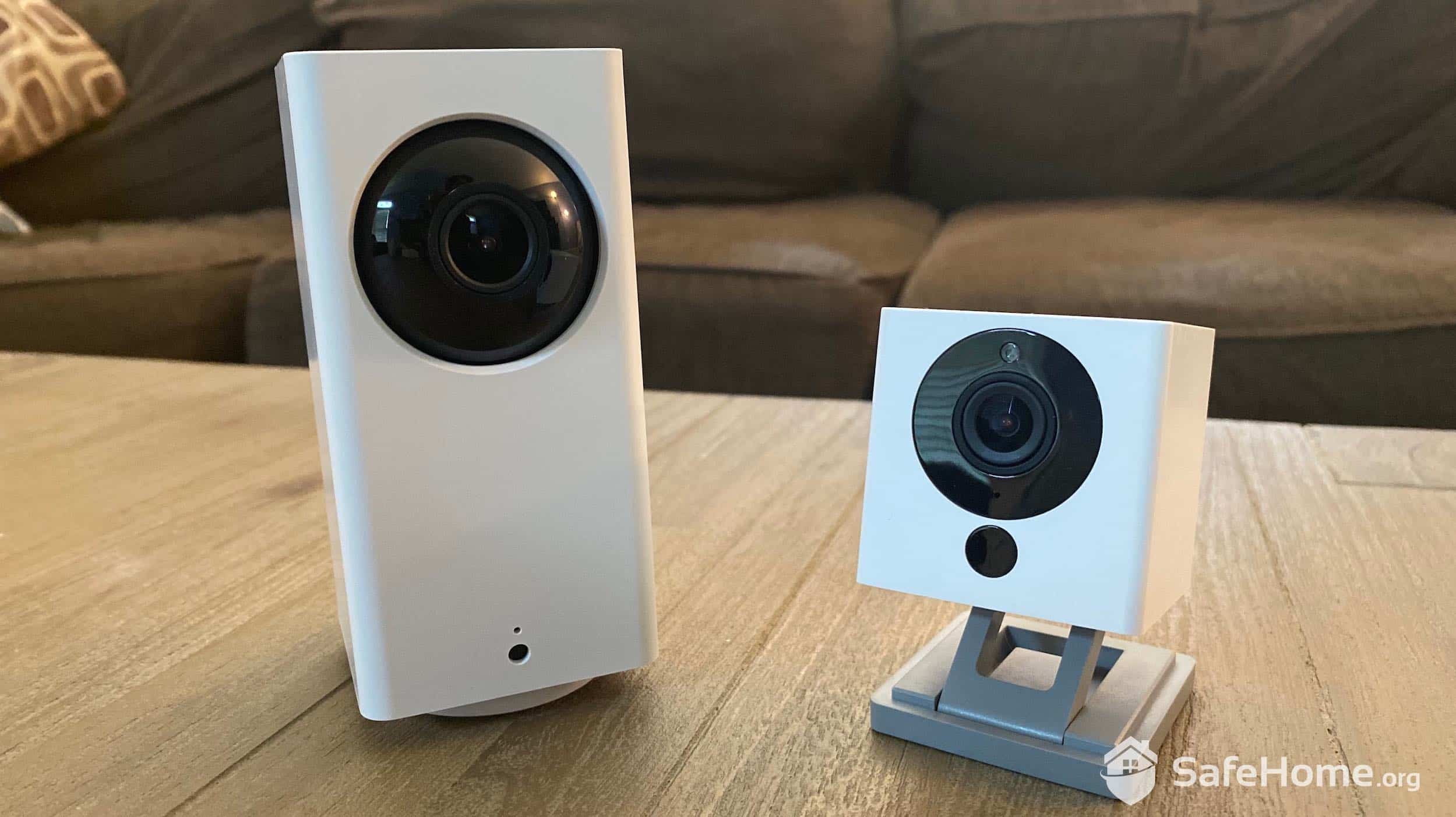
Wyze Cam Pan and Wyze Cam (V2)
We use this feature often as a convenient home intercom (“Time for bed, kids!”). But as an effective crime deterrent, this feature pleases us primarily because there’s nothing like using our own “outside voice” to prevent a crook from choosing our house. As a bonus, many full-service security systems, like Simplisafe, have begun training their professional monitoring personnel to talk directly to anyone who has broken into your home.
With Wyze’s camera packages, we’ll be upfront: The communication is a bit less crisp than the Rings and Arlos we’ve tested. But, again, we still got an effective two-way channel that we knew we could use in a pinch.
With some home security equipment boasting pretty heavy advanced tech, it can be tempting to buy cameras based on how high-tech they are. But it’s important to remember that all that data you’re getting from your high-tech cams is not cheap, no matter which camera you end up with.
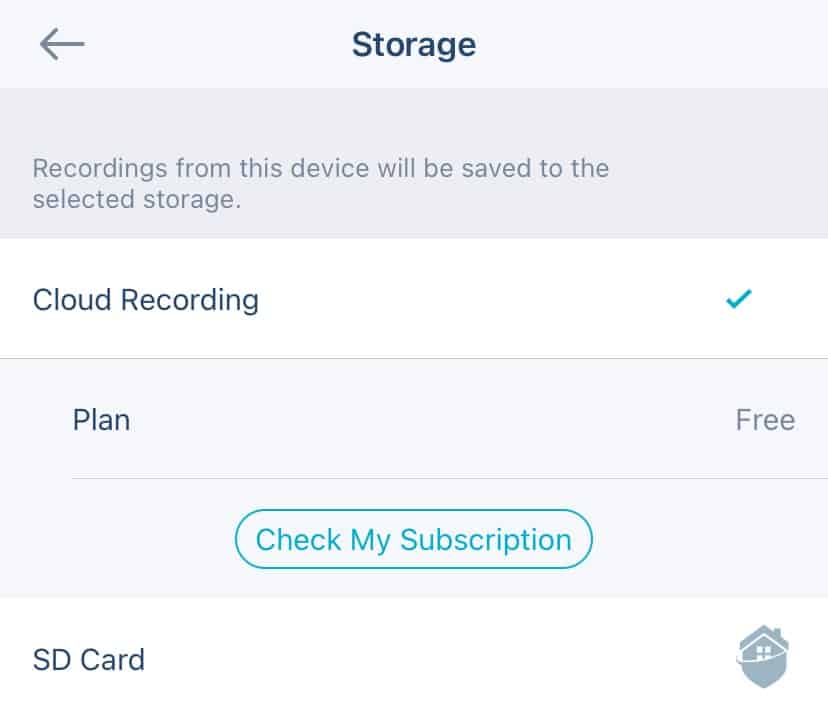
D-Link Storage Options
The costs of storing all those ultra-HD videos with colorized night vision and wide viewing angles can easily get out of hand when it all shakes out. This can be a sticking point for some users, many of whom would rather not blow out their budgets on storage.
We advise caution here. Be realistic; how much time are you really going to spend looking over your footage? Do you really need the cameras to be running 24/7, or are you looking for a camera that records clips and is only activated by motion?
The latter setup, naturally, is more cost-efficient. Your camera won’t need to record everything, so you’ll end up paying less for video storage. We’d say less than $10 per month. This is something we can’t emphasize enough: The costs of securing your home can add up fast, so be sure to account for any monthly fees (like a cloud subscription) when computing the total costs of your security cameras.
Going with a trusted brand like Samsung, for example, could help ensure you get what you’re paying for without any surprises. In our review of Samsung’s Wisenet cams, we learned that the brand had recently discontinued their SmartCloud storage service; while we were initially disappointed, we soon felt comfortable using the camera’s pre-inserted micro SD card to store video. With local storage, we were able to save money on an already affordable system.
Of course, there could be trade-offs if you go with the cheaper, local storage solution. Mainly, if your local storage device gets lost, stolen, or corrupted, you’ll be left with no backup footage. That’s why if your budget allows, we recommend getting both local and cloud storage. Cloud storage stores footage offsite, allowing you to access your recordings whenever and wherever you are.
Another extremely important consideration is exactly how much your camera can see — otherwise known as the field of view. This is measured in degrees, and tells you the angle between the two horizontal edges of the picture the camera displays.
This isn’t a hard-and-fast rule, but generally, the narrower the lens, the most specific your target should be. In our review of Ring’s Stick Up Cam, we noted all of the camera’s features displayed prominently on the box – HD video, two-way talk, motion-activated notifications, easy installation, and a rechargeable battery pack – but no mention of the camera’s field of view.

Ring Stick Up Cam
In bringing the camera online, we got a firsthand look at that view: At 110 degrees, the viewing angle for Ring Stick Up is about average compared to other wireless indoor cams. Nothing earth-shattering, but again, that’s why we set up that camera to monitor our stairway rather than our expansive living room… we knew it had the angle to accomplish the task.
On the flip side, you’ll want a wider-angle lens for monitoring large spaces. For that, a trusty Zmodo Sight 180C tested well, mostly due to a panoramic 180-degree view; it also handled well for us as a pet monitor.
That being said, security cameras with a wider field of view tend to distort the footage, creating a fish-eye effect. A lot of good brands use additional software or hardware to correct that though, so it’s a friendly reminder that having a higher field of view doesn’t automatically give a camera an edge.
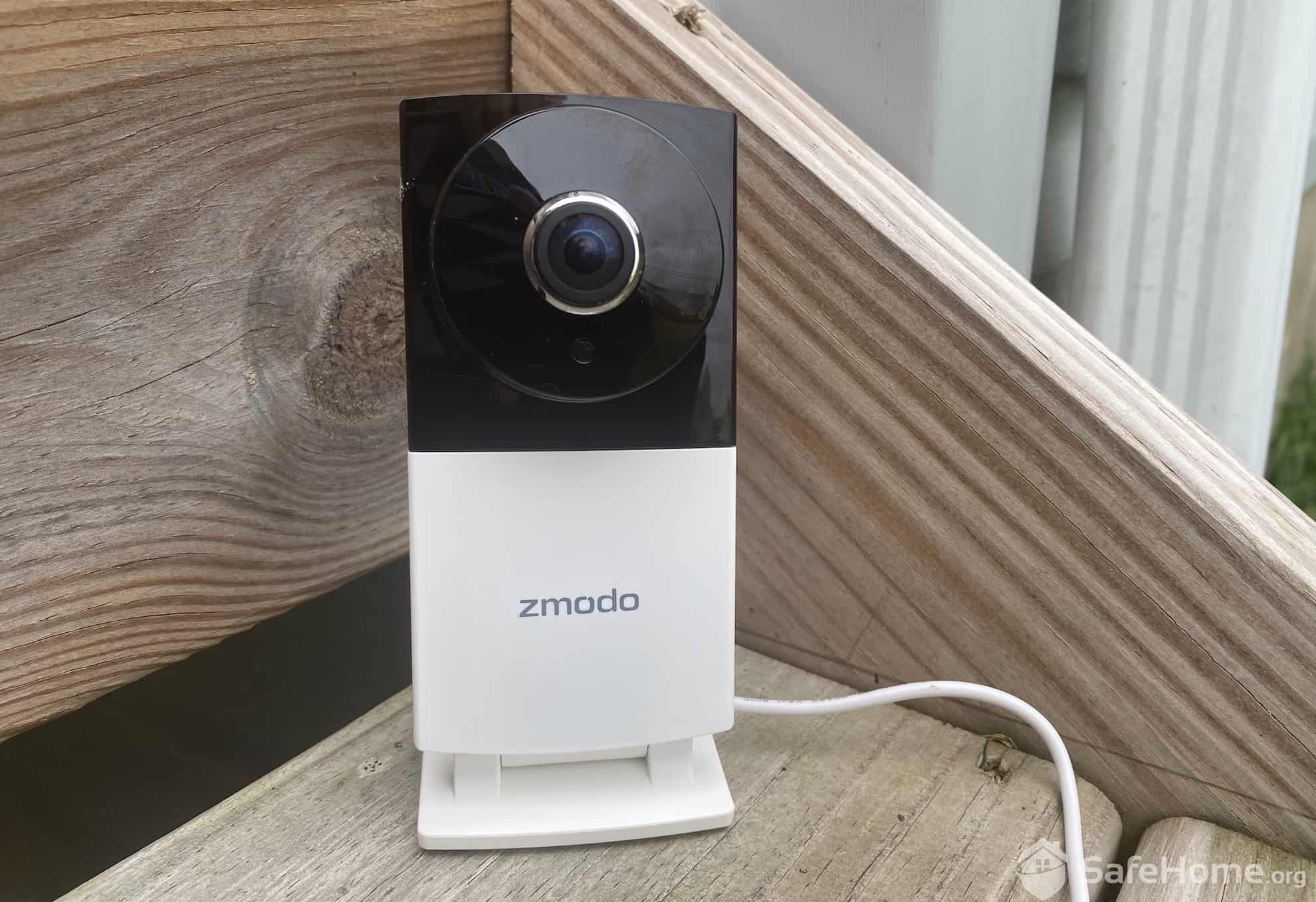
Zmodo Sight 180C Indoor Wi-Fi Camera
A camera’s design – how it’s built as well as how it looks – often reflects the purposes it serves. For example, the no-frills Ring Indoor Cam has a simple, cylindrical design with no weatherproofing or protective cover, so we knew when we tested it that we shouldn’t risk exposing a camera like this to our tumultuous Ohio winter weather.
The Ring Indoor Cam requires wall power, so that meant we needed to place it next to a power outlet. It also has a relatively limited field of view — in this case, 130 degrees — which helps us understand where it should be pointed to keep an eye on what we need. Makes sense.
This chain-reaction approach is common in our review repertoire, and it’s helped us make the most out of our cameras and not get intimidated by their technology. Knowing all this, we always encourage folks not to get too concerned about equipment damage; the majority of outdoor cameras are designed to protect from weather, plus most brands now have pretty straightforward policies if something isn’t right with the camera.
Did You Know? The most common weather rating for outdoor cameras is IP-65, which means that it’s dust-tight and watertight against light water pressure spray. That’s usually enough to protect from most damage, barring extreme flooding. As users, we think it’s extremely important for cameras to be rated for weather. After all, these devices are supposed to provide peace of mind, right?
We love pan-tilt-zoom (PTZ) cameras because they’re a nice, economical option for apartment dwellers and homeowners alike. We’ve met a few cams with some very unique PTZ builds, with mechanical lenses that rotate Exorcist-style to allow us to see more out of our space than ever before. And we have to say, this can be a super convenient option; we know we’re getting one camera that covers a whole lot of ground, with little else to worry about.
Numerous brands, including Reolink, D-Link, Lorex, Amcrest, Wyze, and Swann, carry their own versions of pan-tilt cameras. As we mentioned earlier, brands with massive selection can be confusing, so if you’re looking for new and innovative features in a PTZ device, we advise giving the Amcrest ProHD a second look. We did a deep dive on this cam in our hands-on Amcrest camera review, if you’re interested.
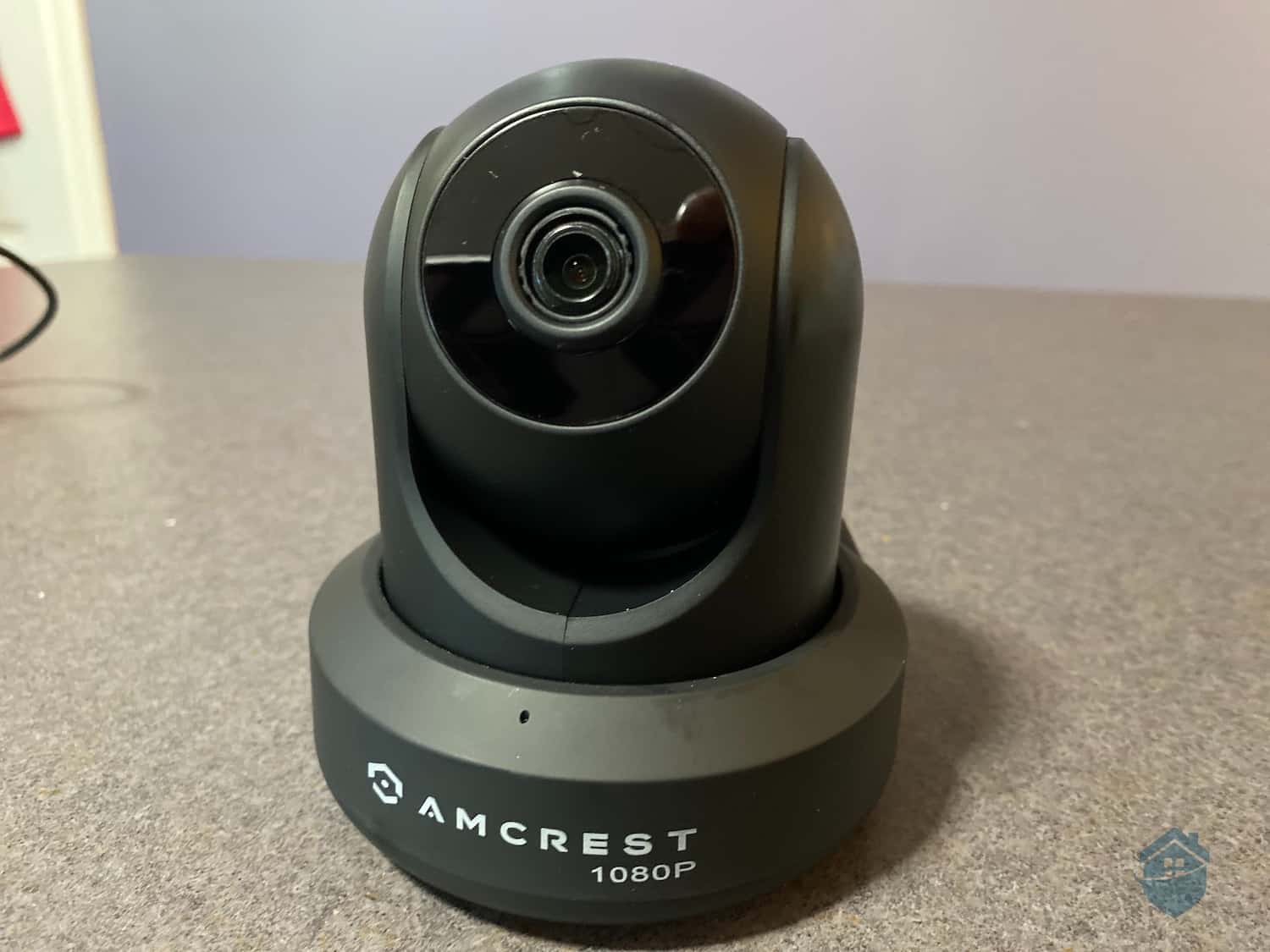
Amcrest Indoor Pan-Tilt Camera
Once used strictly by professional security systems, emergency connection is starting to pop up in standalone security cameras, too. But since we’re talking about wireless technology, a couple of camera packages are starting to appear with a thumbprint-activated safety feature we can tap from anywhere.
A select few cameras we’ve tested have joined forces with Noonlight, a security tech startup that helps self-monitoring security camera users dispatch emergency services without having to call 911.
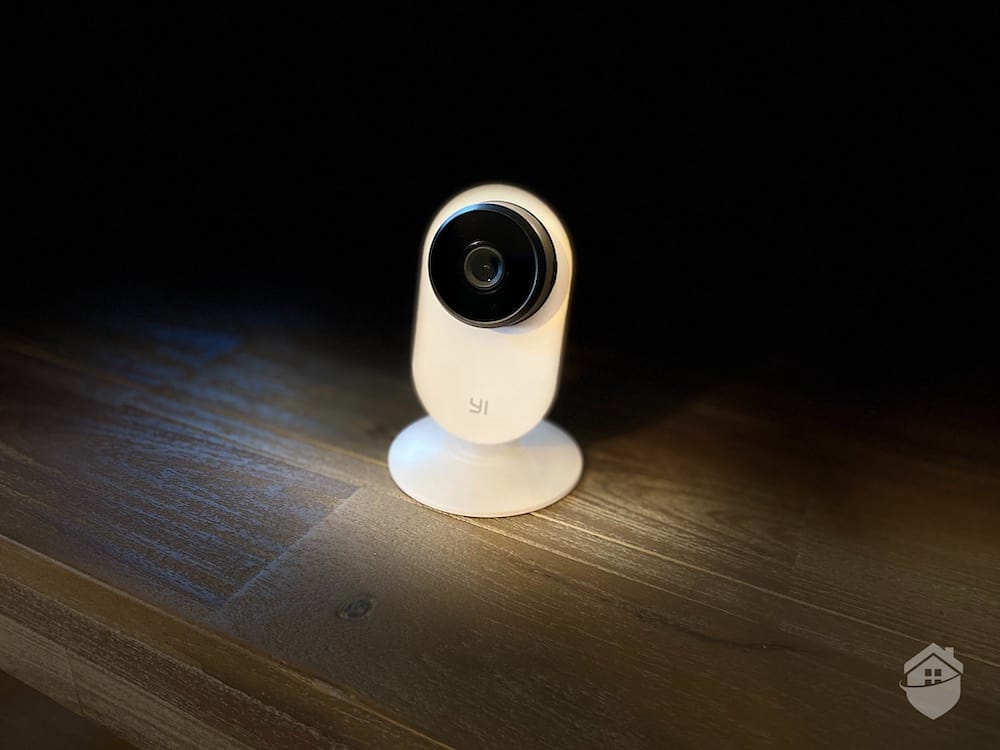
YI Indoor Camera
We don’t see this emergency connection feature routinely in cameras yet, but when we do, it really amazes us. Take a look at our YI Home 3 camera review, where we discovered the 24/7 emergency service in an otherwise basic $19.99 indoor camera. Though it did involve signing on to a separate subscription, we do think you’ll appreciate the extra layer of safety here. If something goes terribly wrong, the monitoring center can dispatch 911, EMS, or Fire. Features like this are crucial for the elderly and those who live alone.

YI Camera – Emergency Response
When we did our hands-on review of Canary cameras, we were spoiled by this feature, since they don’t charge a separate fee beyond the standard Canary subscription. But we’d be remiss if we didn’t mention that Canary’s equipment costs are significantly higher than YI’s, so keep that in mind.

Canary Emergency Butto

How does your home measure up when it comes to security? Take this quiz to see how you score, and get recommendation to protect your home.

With so many choices in this market, we’ve found that we pay widely different prices for equipment and monthly monitoring depending on which camera or brand we choose. Here are a few pointers to help you demystify the somewhat confusing world of security camera prices:
When choosing equipment, it might feel like you’re balancing on a seesaw. Do you want to pay one price upfront for the equipment, or break it down into a monthly subscription for storage and usage? Do you want to pay a lot now and a little later, or a little now and a little more later, or nothing now and everything later? Don’t worry… we’ll break this down.
Each brand has its own unique model for pricing, and again, it all comes down to preference. We, personally, like using a micro SD card in our cameras and storing our footage there, the way Lorex’s cameras do, so we’d ideally want a camera that gives us this option.
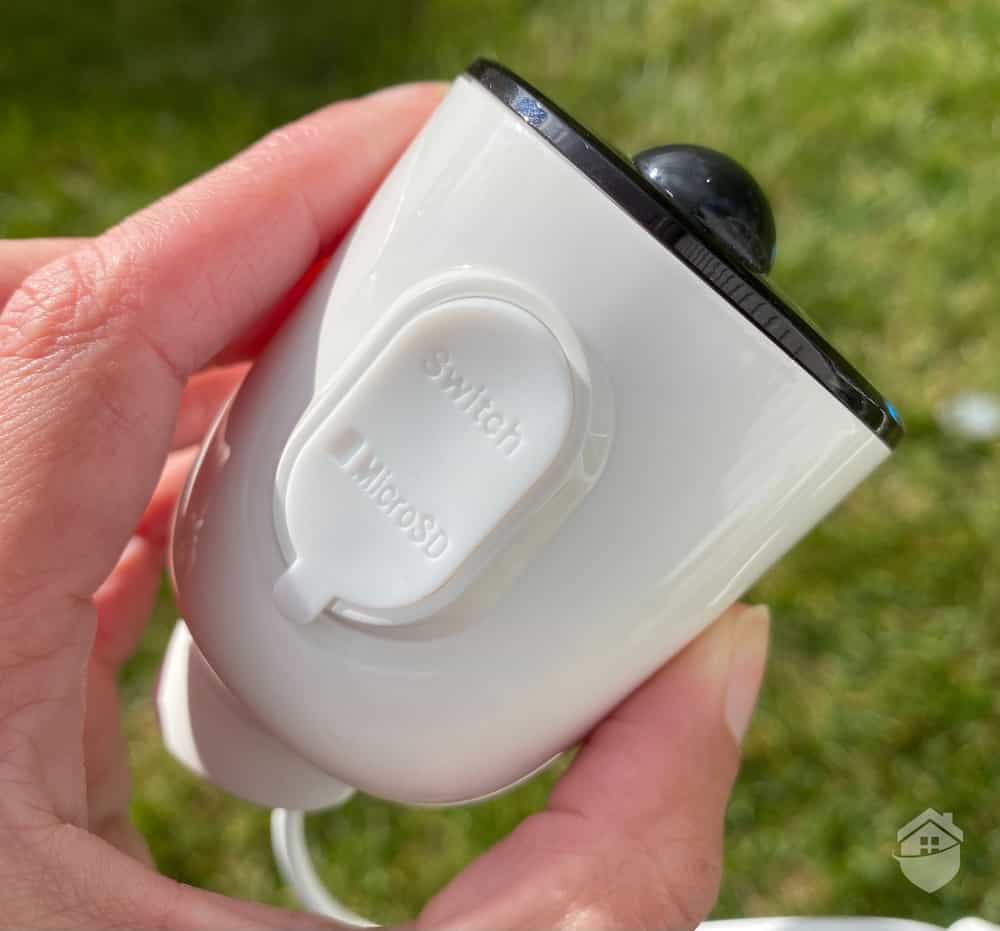
Reolink Argus 3 MicroSD Slot
Of course, using local storage gets us out of any monthly subscription fees the camera might offer as an add-on. This way, we don’t have to sign up for a cloud subscription, which in most cases is pretty inexpensive per month but can surely add up over time.
Pro Tip: Want to get the full scoop on security camera costs? If so, head over to our in-depth guide to home security camera pricing.
Micro SD cards are also pretty inexpensive and widely available; a few brands have even added pre-inserted cards to their cameras in recent years. Wyze, a brand of super-affordable, no-frills cams, allowed us to add Wyze-branded SD cards to our purchase. And we were especially pleased to find we could use those cards to store data from other devices, too.
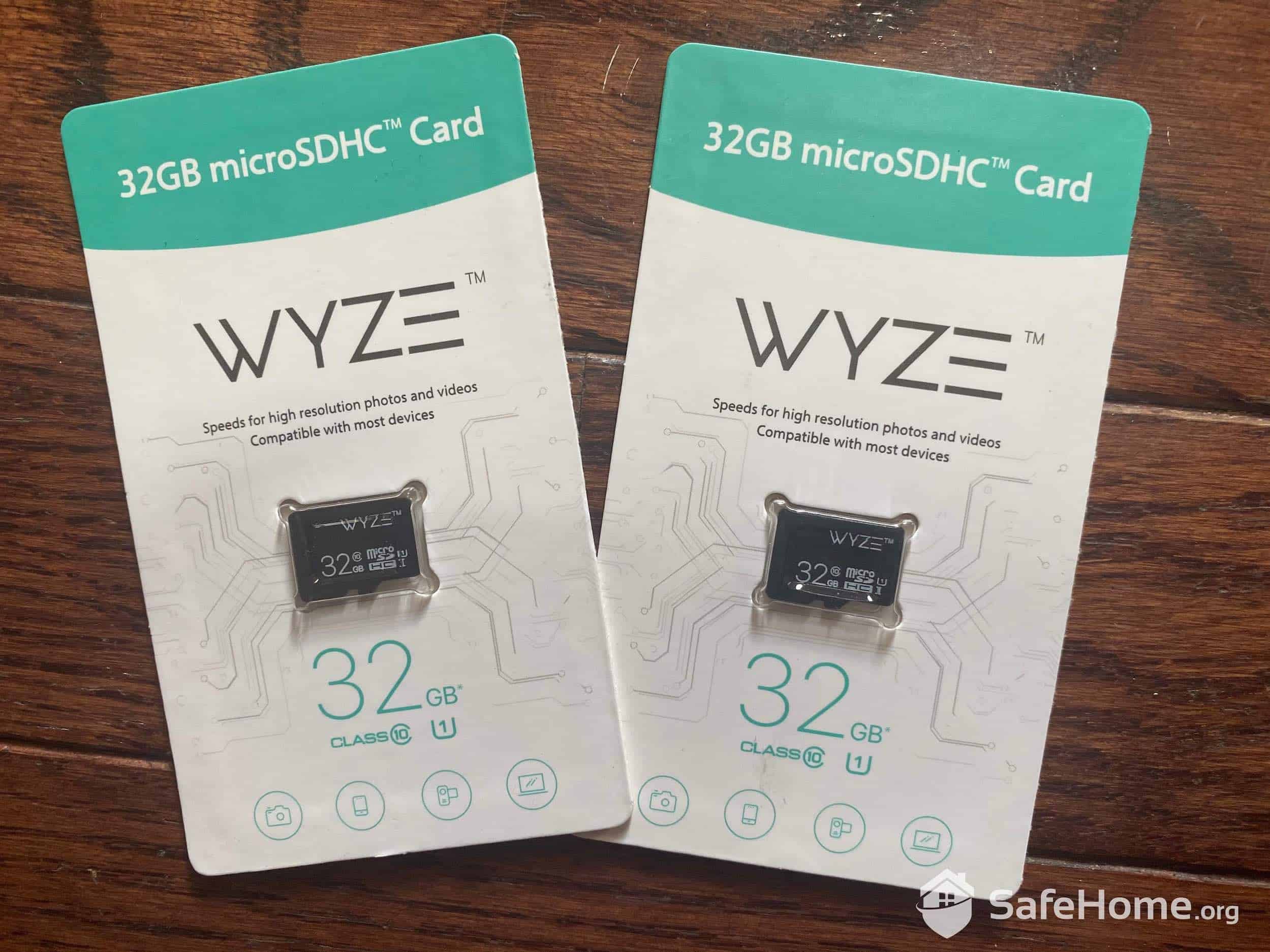
Wyze SD Cards
Beyond these options, we’ve also seen a lot of attractive combination packages that charge one price for monitoring and equipment all together. Canary cameras, for instance, give you the option to sign up for their comprehensive service plan for $9.99 per month and they’ll toss in the equipment — in this case, the Canary View — for no extra cost. The downside? You’ll have to sign a long-term contract.
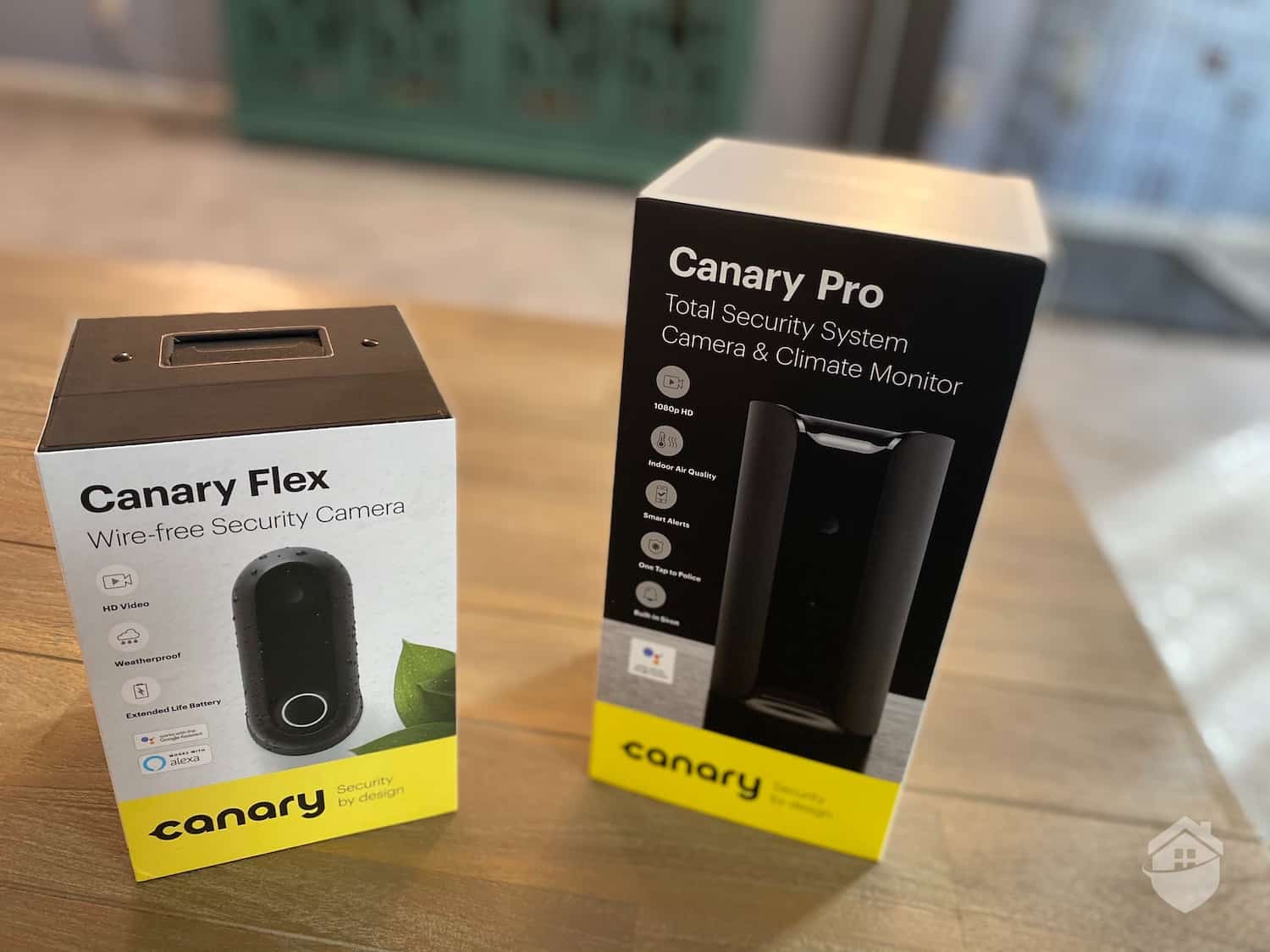
Canary Packaging
We regularly see bundles similar to this across more traditional brands, too, like Lorex, with its emphasis on local storage and no monthly fees. We’ve long recommended Lorex as an affordable way to buy multiple cameras at once, with low-cost options starting at $35. But beware, if you are someone easily overwhelmed by an enormous menu of choices, Lorex may not be your best bet. Still, we think Lorex is a great option for many, especially bargain hunters. Check out our hands-on Lorex camera review to learn more.
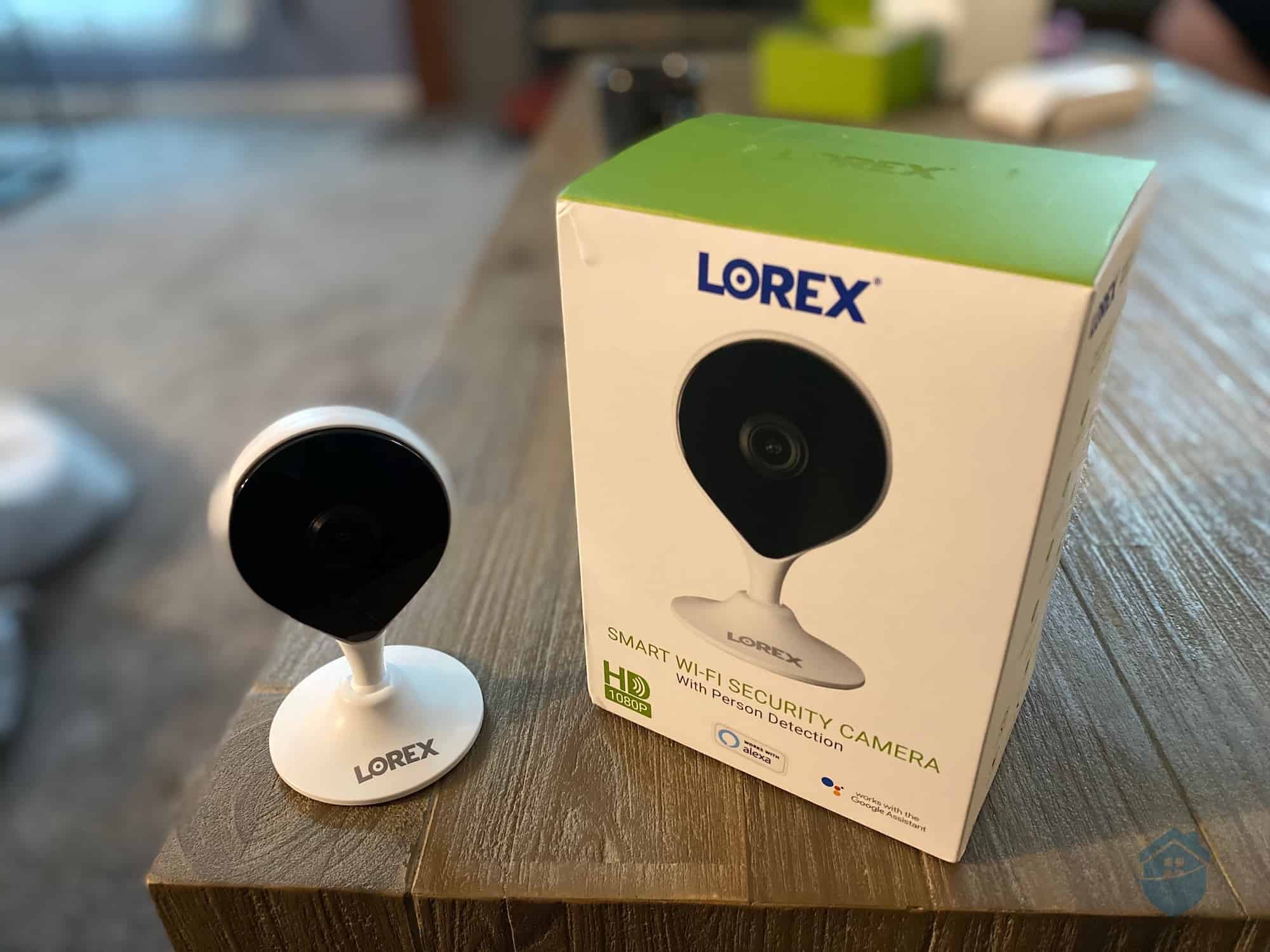
Lorex Indoor Camera and Box


Once you bring your shiny new cameras home, where do you plan to put them?
You don’t have to commit to one location with a wireless camera, one of many reasons we enjoy testing and reviewing them. But the biggest determining factor we consider when deciding where to display a new camera is whether it’s an indoor or outdoor device.
We think you will find, on the whole, that indoor cameras tend to display better on surfaces, such as fireplace mantels and bookshelves.
And even when we decide to mount an indoor camera on a wall, that process is no more difficult than hanging, say, a diploma above our office desk. It gets even easier if we get one with batteries; check out our hands-on Canary Flex review, where we discovered the versatility and simplicity of the brand’s magnetic mounting equipment combined with wire-free installation.
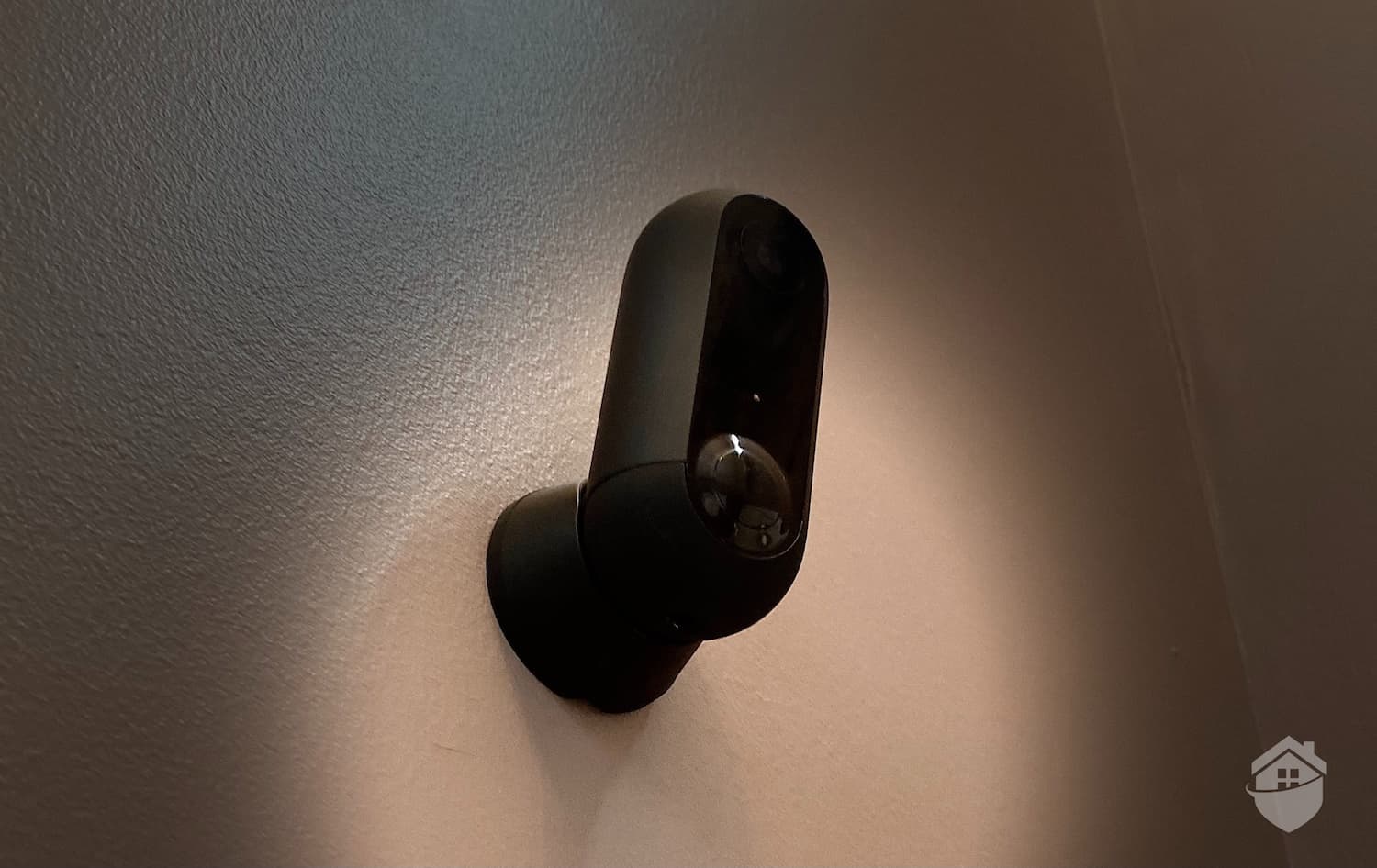
Canary Flex Mounted on Wall
Setting up cameras around your home’s exterior, in areas where would-be burglars might see them, not only makes practical sense, it also makes a huge difference in terms of peace of mind.
FYI: Security cameras can see a lot, but they can’t see every threat lurking in your home. Check out these four hidden dangers that might be in your attic right now.
When we took an outdoor camera from Ezviz for a spin, we were reminded of the intimidating presence of cameras of decades past; the tough exterior and bulky build gives off an impression that anyone who crosses its path knows we mean business. For a pair of working parents like ourselves, this is more than just a wish-list item; we want the camera to scare criminals away, and whatever it takes to achieve that, we’ll do it.
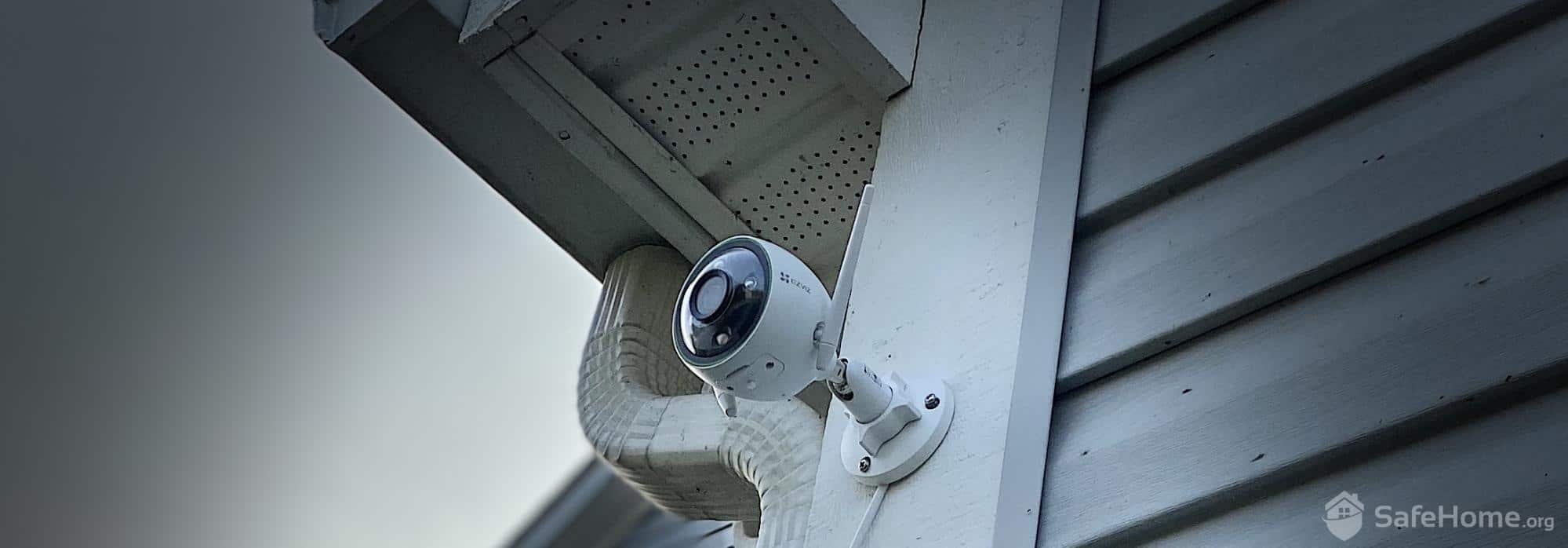
Ezviz C3N, installed outdoors
For what it’s worth, we didn’t witness any funny business outside our home during our Ezviz testing period; you can learn much more about this intimidating camera in our hands-on Ezviz camera review.


While brand labeling in this biz can sometimes confuse, just remember that security cameras with “wireless,” “IP,” or “Wi-Fi” technology all require an Internet connection to work.
You might see “wireless cameras” and “Wi-Fi cameras” used interchangeably across the many camera brands we’ve reviewed out there. That’s because, by and large, they’re the same thing: Cameras that work off a Wi-Fi network rather than physical wires to transmit data.
>> Related: How Do Wireless Security Cameras Work?
That said, wireless cameras might still require you to plug in a power cord for the actual device to work (unless it has batteries, which we’ll explain in a sec), so do keep that in mind.
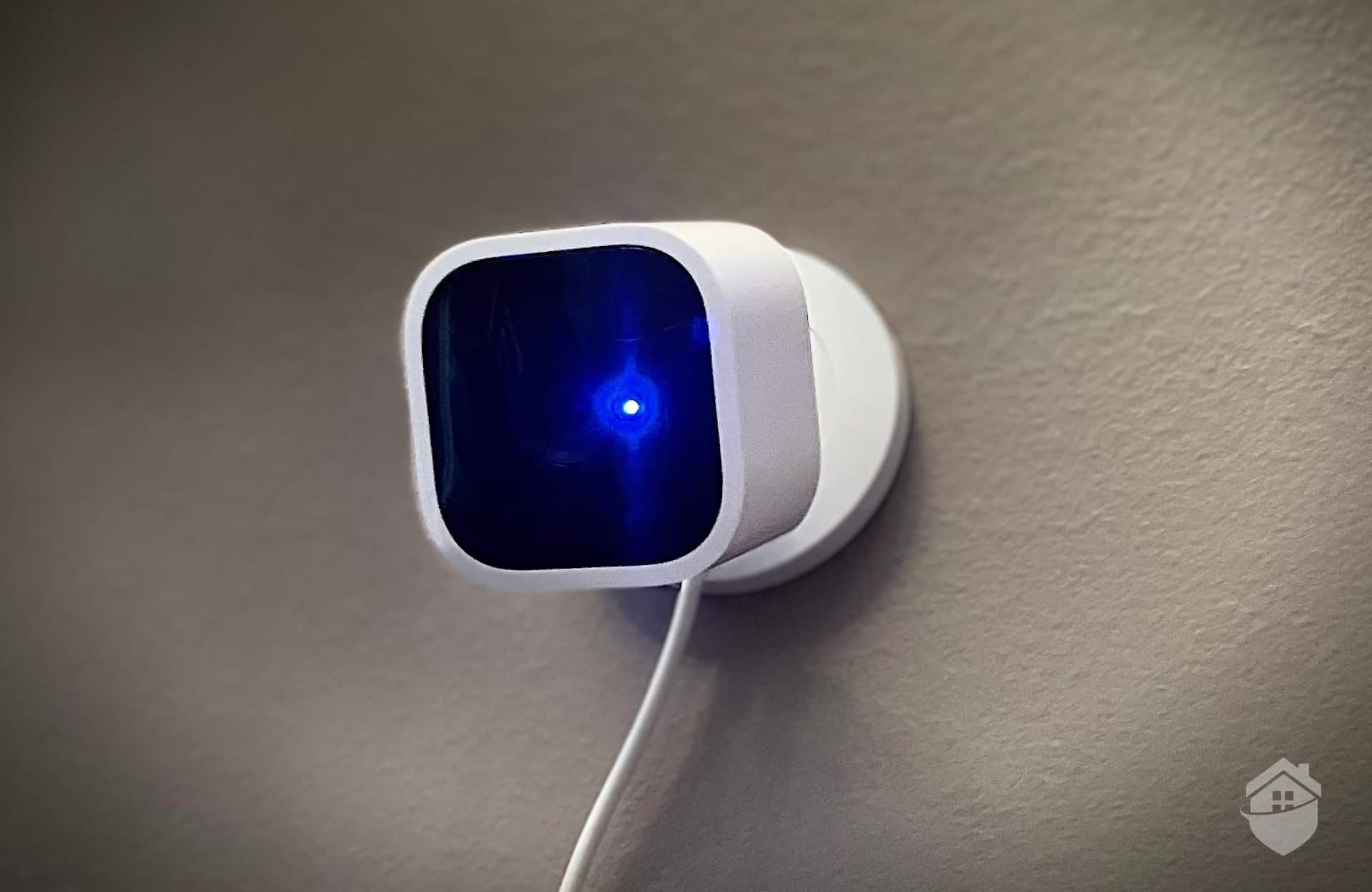
Blink Mini Mounted
Not to further confuse you, but wireless cameras are also different from wire-free cameras. This is important to understand because with something as vital as a security camera, you don’t want to be caught unaware when it’s time to change the batteries.
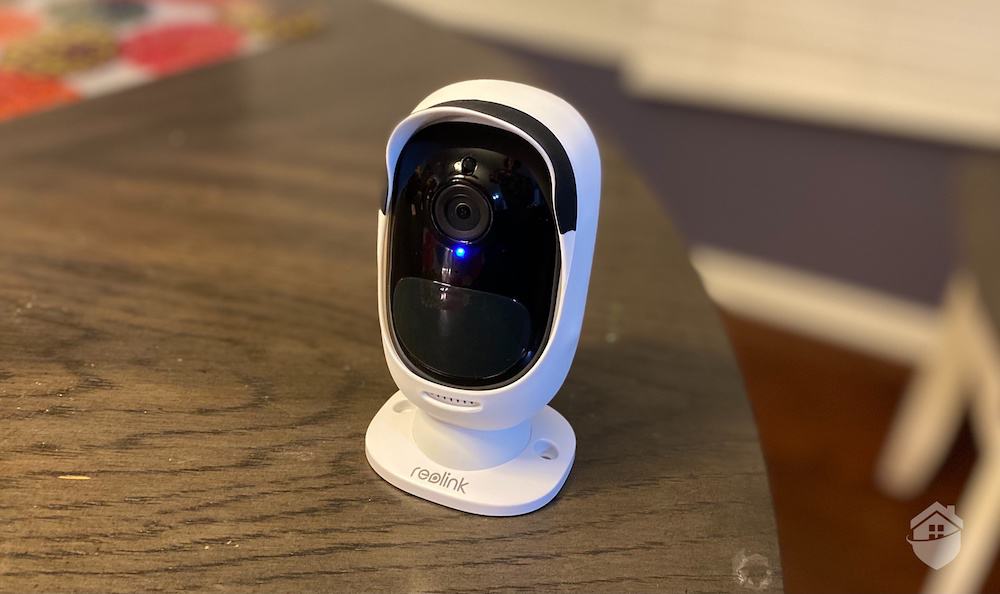
Reolink Argus 2 Camera with Protective Sleeve
To keep things simple, remember that wireless cameras might not contain batteries, but wire-free ones always do. If you want a wire-free camera, expect to pay about $10-$20 more than you would with a wireless (plug-in but still Wi-Fi) camera. And, on top of that, expect to change the batteries on an intermittent basis; for us, this tends to vary based on how often the camera is triggered.
Reolink’s Argus 2 cam seemed to hold its own as a wire-free indoor camera with batteries that lasted a really long time for us; it doesn’t hurt that this camera was easy to install and move around the house, too. It’s one of many positive experiences we had with Reolink cameras; learn more in our in-depth Reolink review.


It’s not as common these days, but we still see a good number of NVR and DVR-based camera systems for residential use. In systems like this, we can store a decent amount of video history through the NVR without the need to sign on to a monthly cloud subscription or attach a memory card.
This hard drive configuration tends to work great for covering large spaces, but more important, it’s a great way to record and store video on those 2K and 4K ultra HD cameras that are becoming more commonplace.
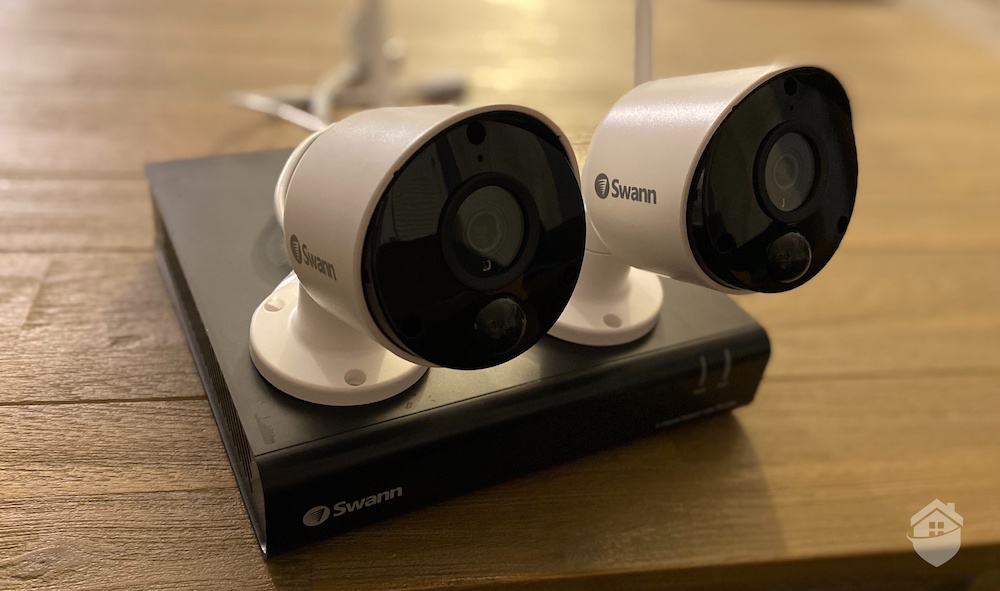
2 Swann Cameras on the NVR
Remember, though, that a NVR or DVR system, like the Swann 2-camera NVR kit we reviewed, will leave you with an unwieldy black box. If you’ve got the space and don’t mind the extra machinery, this shouldn’t bother you much; personally, we prefer to keep the gadgets to a minimum to avoid clutter. But that’s just us.
FYI: While NVRs differ from DVRs in the way they process video footage, they do share one key advantage over a cloud system: You can view your camera’s footage remotely without relying on an Internet connection. If that’s a good fit for you, consider giving Swann or even a larger brand like Amcrest a look.


Though we’ve seen professional monitoring (for cameras) offered less and less these days, it’s still a worthwhile consideration in your camera search. Here, the question comes down to whether you want to pay for a third-party monitoring service that will alert authorities to any relevant threats in your home, or you prefer to monitor your system yourself.
To many of us, cost is the determining factor here. But no matter what your budget is, the No. 1 factor we focus on in cameras with professional monitoring is whether the service actually works.
In a recent review, one of our team members put a Cove system of cameras, sensors, and an alarm to the test, and came away with one very important takeaway: The police do, actually, show up. If that isn’t a testament to the effectiveness of home security equipment, we’re not sure what is.
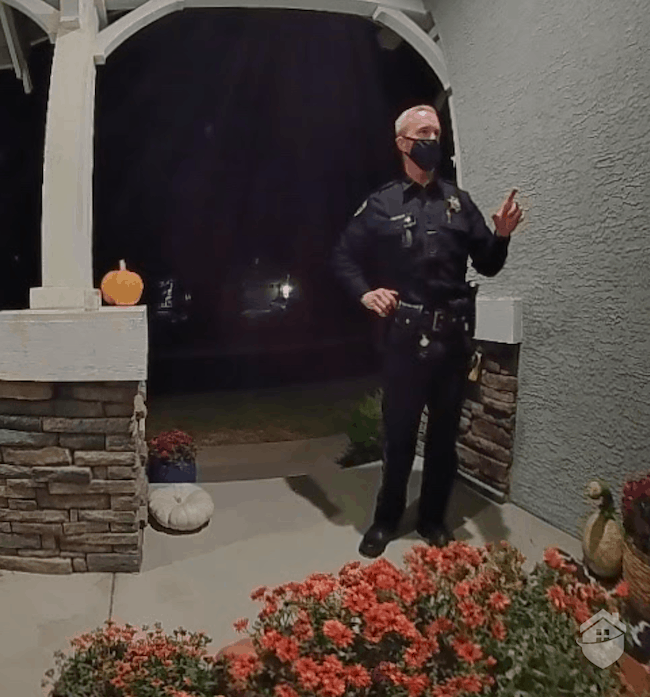
Police Officer checking up on us thanks to Cove Monitoring
For more on that interesting experience, head over to our hands-on Cove security system review. But in the meantime, we’ll say this: Cove happens to have one of the least expensive monthly monitoring fees in this biz. So if you are interested in professional monitoring, a Cove kit might be the way to go. Clearly, it does work! Other great options for whole home security include Ring Alarm, SimpliSafe, and Frontpoint.


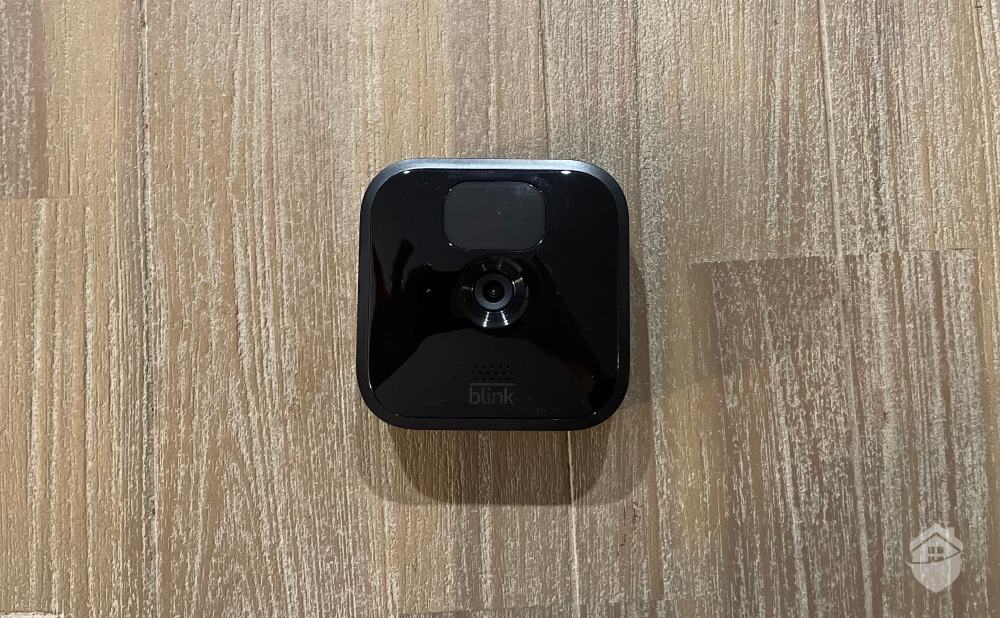
Blink Outdoor Camera
We hope that in this ultimate guide to home security cameras we’ve given you a lot to think about when you’re considering surveillance for your home. Taking the time to assess the features and tech that sets these cameras apart, and using our hands-on experiences as a guide, should help you make a smarter, more economical decision about your home security needs.
We always look forward to exploring what new tech and features our favorite camera brands will release each year. Our team feels that the future of home security will be how well they integrate overall into a smart, connected home. People want more control, more integrations, more convenience, but above all else, more peace of mind.
Beyond our guidance here, we’ve published plenty of resources for even more help in the camera buying process. We suggest you start by checking out some of our best motion sensor cameras.

C+R Research. (2020). 2019 Package Theft Statistics Report.
https://www.crresearch.com/blog/2019-package-theft-statistics-report
Blickenstaff, B. (2017, June 14). The PTSD of Home Burglary. Pacific Standard.
https://psmag.com/social-justice/home-burglary-invasion-psychological-space-88129
Statt, N. and Dieter, B. (2019, May 7). Google Nest: Why Google Finally Embraced Nest as its Smart Home Brand. The Verge.
https://www.theverge.com/2019/5/7/18530609/google-nest-smart-home-brand-merging-hub-max-rebrand-io-2019
Shulevitz, J. (2018 November). Alexa, Should We Trust You? The Atlantic.
https://www.theatlantic.com/magazine/archive/2018/11/alexa-how-will-you-change-us/570844/
Morrison, S. (2020, August 24). Contracts, Hacks, and Google: What to Consider Before You Get a Home Security System. Vox.
https://www.vox.com/recode/2020/8/24/21354628/home-security-adt-google-ring